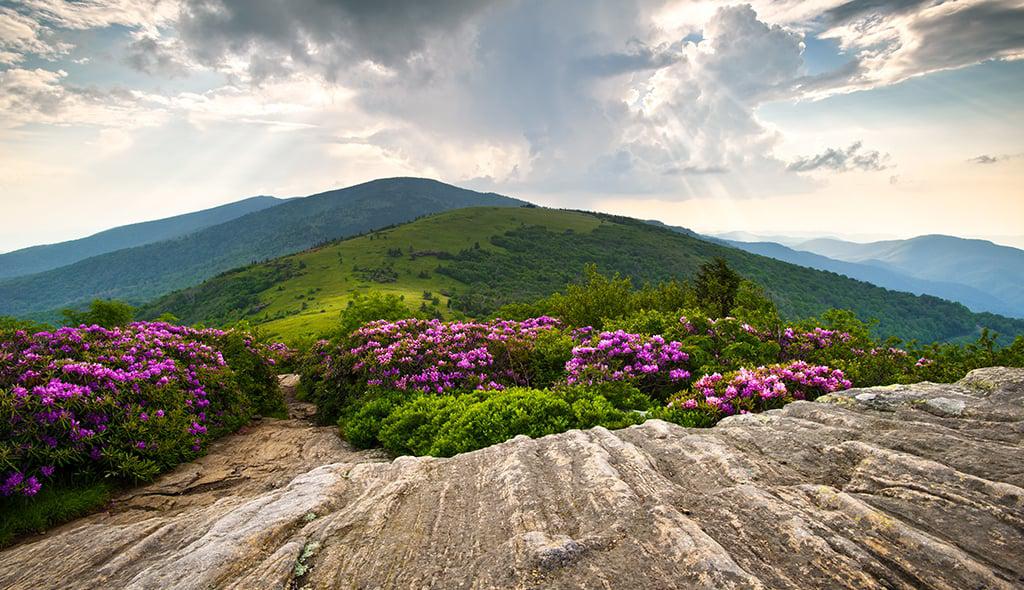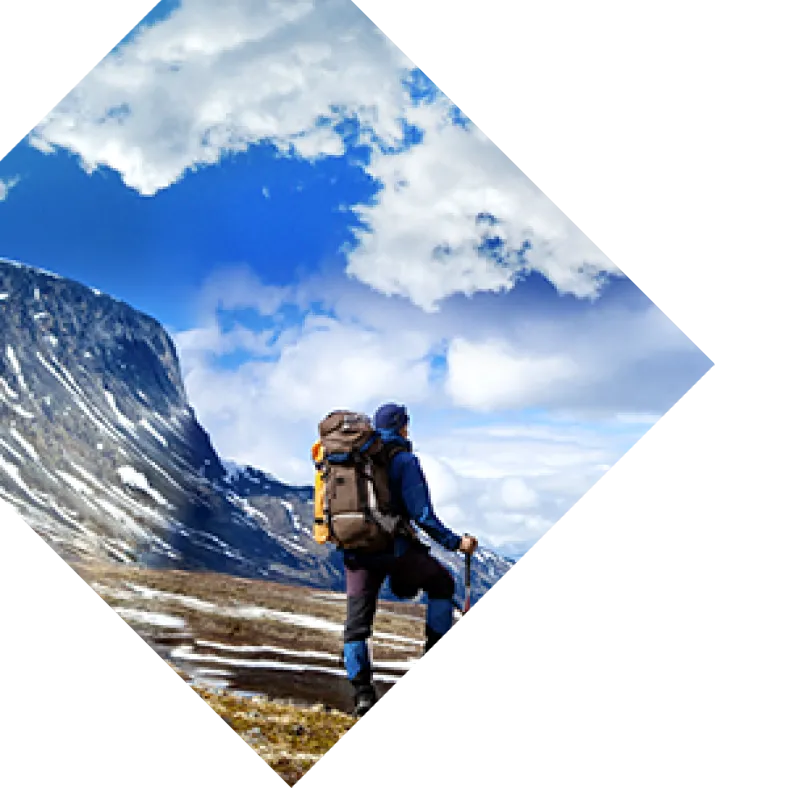 So often, the East Coast’s day hikes get overlooked in favor of the famed metropolitan areas. But, if you’re willing to look beyond the hustle and bustle of city life, you’ll find a glorious network of hiking trails just begging to show you a thing or two about densely forested bushwhacking and steep, rocky ascents. These are a few of the best hikes on the East Coast, but the list is by no means comprehensive; what would you add?
So often, the East Coast’s day hikes get overlooked in favor of the famed metropolitan areas. But, if you’re willing to look beyond the hustle and bustle of city life, you’ll find a glorious network of hiking trails just begging to show you a thing or two about densely forested bushwhacking and steep, rocky ascents. These are a few of the best hikes on the East Coast, but the list is by no means comprehensive; what would you add?
Katahdin Knife Edge Trail, Maine
Mount Katahdin, the highest peak in Maine, stands at 5,267 feet inside of Baxter State Park. This famed mountain looms as the northernmost point on the iconic Appalachian Trail, and for good reason. While there are other trail options to reach the summit, none are more daring and adventurous than the difficult Knife Edge Trail. Hikers can reach the Knife Edge portion from various entrances. From the west/southwest side, trekkers can choose to use the Hunt Trail or Abol Trail. From Roaring Brook Campground, there is the Helon Taylor Trail or the Chimney Pond Trail to Chimney Pond. From there, the Dudley Trail, Cathedral Trail, and Saddle Trail will all get you to where you need to be, with Saddle Trail being the easiest (yet most circuitous) option. Regardless of which you choose, the trail will dump you on the Knife Edge, where you will be rewarded with thrilling views, gusty winds, and a challenging day full of scrambling.
Trail Beta:
Length of trail: 1.1 miles (in addition to the 7-8 miles of trails that will get you to the Knife Edge, depending on which you choose) Season: Spring, summer, or fall Difficulty: Strenuous
Jacks River Trail, Georgia
If you’ve never heard of Georgia’s Cohutta Wilderness, you’re in good company. This beautifully remote area in the northern part of the state is well worth a visit. The Jacks River Trail follows its namesake river as it winds through a verdantly lush valley filled with exploding waterfalls and babbling stream crossings. Truly, you get a little bit of everything with this trail, and if you want to turn it into a longer overnight, trek the 9.3 miles out to Jacks River Falls, post up for the night, and trek out in the morning.
Trail Beta:
Length of trail: The entire trail stretches over 16 miles Season: March-September Difficulty: Moderate
Old Rag Mountain via the Ridge Trail, Virginia
Old Rag Mountain in Shenandoah National Park is one of the most popular hikes in the area, and for good reason. Spectacular panoramic views highlight the experience while an exhilarating scramble caps off an adrenaline-filled day. Many will argue that this is the best hike in the park, so you know you’re in for a treat! Most hikers prefer to hike Old Rag in a clockwise loop, tackling the difficult scramble on the uphill, but it can be done in either direction. Regardless, be aware that the scramble is tough, and it’s best to conquer that portion of the hike while you are fresh and aware. Crowds can turn this section into a bit of a conga line, so it’s best to start early!
Trail Beta:
Length of trail: 9.1 miles Season: Year round Difficulty: Strenuous
Ocean Trail, Maine
If you are hoping for an easier day hike with eye-popping ocean views, this one will do the trick. Housed in Acadia National park, this family-friendly trail is largely flat as it meanders between Sand Beach and Otter Point. There is parking on either end, and hikers are rewarded with views of rocky coves and even rock climbers scaling the walls of Otter Cliffs. If you enjoy walking the boundary line between land and sea, definitely check out the Ocean Trail.
Trail Beta
Length of trail: 3.6 miles Season: Year round Difficulty: Easy
Mt. Washington via Tuckerman Ravine Trail, New Hampshire
Mt. Washington is a tourist attraction largely for its accolades; it’s the highest point in New England (6,288 feet) and it’s reputed to be the home to the “world’s worst weather.” Regardless of your stance on the latter, Mt. Washington is a must-hike peak and the summit views are epic; just be aware that you won’t have solitude! Even though the Tuckerman Ravine trail is fondly referred to as a “Disneyland hike” thanks to the crowds, this 4,186 feet of gain is no joke. The weather truly can change in a minute, so hikers need to be prepared for anything. In the last push to the summit, be careful to follow the cairns and stay on the trail. This is an easy feat in good weather but if nasty stuff rolls through, staying on-route becomes more sporting.
Trail Beta
Length of trail: 8.2 miles (roundtrip) Season: March-October Difficulty: Strenuous
Mt. Colden via Avalanche Pass Trail, New York
We’d be remiss to exclude any Adirondacks trails from our list, and Mt. Colden is a gem of the first water. This stunningly beautiful loop hike uses the Avalanche Pass hike, which is steeper (boasting a section known as ‘Misery Mile’) but arguably more scenic as it climbs passes through Avalanche Pass before ascending Mt. Colden from Colden Lake. Staircases are used in the steepest sections, so think of this as Mother Nature’s stairmaster.
Trail Beta
Length of trail: 14.75 miles Season: Late summer-fall (avoid mud season to prevent damaging trails) Difficulty: Strenuous (steep staircases and ladders)
Hawksbill Mountain via the Upper Hawksbill Trail, Virginia
Known as the tallest mountain in Shenandoah National Park (4,049 feet), Hawksbill Mountain is a great area for wildlife spotting, especially if you are interested in birding. Birds of prey are a wondrous site and peregrine falcons can frequently be spotted soaring above the trail. The Upper Hawksbill Trail is the easiest, most direct route up to the summit, and is clearly marked with blue blazes. Near the summit, you should spot Byrd’s Nest Shelter, a day-use area that will be one of the first indications you are close to the top. Camping is prohibited, but it’s a great place to rest for a lunch break.
Trail Beta
Length of trail: 4.2 miles RT Season: Year round Difficulty: Easy
The Presidential Traverse, New Hampshire
Let’s be honest: this traverse is not for the faint of heart, and anyone wanting to tackle the entire thing in a day should seriously evaluate their physical prowess before embarking upon this hike. For those who are willing and able, the Presidential Traverse is a rite of passage for many hardcore hikers in the east. Covering 23 miles and almost 9,000 feet of elevation gain, this traverse is typically done from north to south, beginning with Mt. Madison (5,367 feet) and concluding with Mt. Jackson (4,052 feet). Weather can be nasty and hikers need to be prepared for anything. Of course, you certainly don’t need to tackle this as a day hike and can split it into 2-3 days if it sounds like too much. If you opt for the whole shebang in a day, be prepared for a pre-dawn-to-dusk day. Note: Study the bailout points before attempting so that you are prepared for unforeseen accidents.
Trail Beta
Length of trail: 23 miles Season: Can be done year round, depending on experience level Difficulty: Extremely strenuous
Rocky Top Trail, Tennessee
If you enjoy trails that inspire a bit of nostalgic collegiate folklore, then Rocky Top is the trail for you! This scenic hike is known to be the inspiration for the University of Tennessee’s fight song, which is now the official song for the state. That aside, it’s a hike worth doing for the views alone, but note the elevation gain (4,389 feet). Beautiful rhododendrons line the trail, opening up to a 360-degree panoramic view at the summit. It can be crowded, but the views are top-shelf.
Trail Beta
Length of trail: 11.6 miles Season: Year round Difficulty: Strenuous
Be Prepared
As with any hike, it is important to be prepared and have the proper hiking gear before embarking on the trail. In particular, be sure you have quality hiking footwear before setting out. Hiking shoes with good tread and support are critical, especially on strenuous hikes like the Presidential Traverse. Additionally, be sure you have enough clothes to keep you warm should the situation go awry; we always recommend packing insulation and a waterproof shell. Finally, always carry extra food and water with you. It may feel like a pain, carrying the extra weight, but you’ll be thankful for the extra calories if you get stuck out there longer than planned. Truly, any prepared hiker should always carry the Ten Essentials with them. Read up on them and make sure you have what you need before tackling your next day on the trail.





